Yet many people especially beginners are still confused about the fishing rods materials and how to choose the best one. In today’s article,I will show you every piece of detail on different rod materials and all the components of a fishing pole. You can look through the quick list to find the part that you want to dive into.
Quick List
- What Are Fishing Rods Made of? (6 Parts Included)
- Six Materials and Comparison of Rod Blanks
- What is the Best Material for a Fishing Rod?
- Materials of Fishing Rod Handle
- Materials of Fishing Rod Tip
- Materials of Fishing Reel Seat
- Materials of Hook Keeper
- Materials of Rod Guides
- Are Expensive Rods Really the Best?
- How to Choose Fishing Rod for Beginners?
- Future Trend of Fishing Rods
1. What Are Fishing Rods Made of? (6 Parts Included)
In this article, I will list the materials of all the parts of a fishing rod, so first let’s see what a fishing rod is made of. A fishing pole mainly includes:
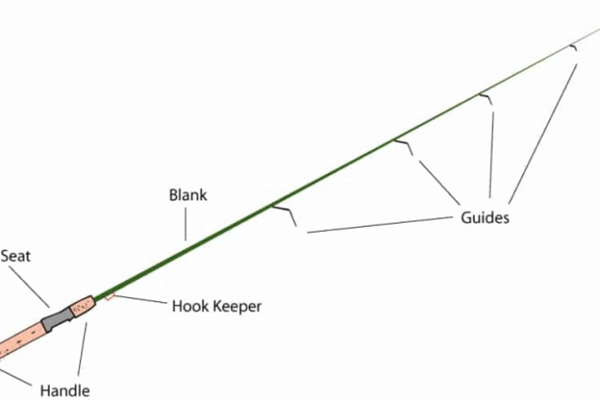
- Rod blank
- Handle
- Reel seat
- Hook keeper
- Tip
- Guides
2. Six Materials and Comparison of Rod Blanks
A rod blank is a long and flexible pole component of a fishing rod. It is the basic but core component before the handle, reel seat, and guide are attached. The fishing blank comes to be the most important part, so the fishing rod blank material will largely influence the fishing experience and where you fish.
Typically the material of a fishing rod blank includes bamboo, fiberglass, graphite, carbon fiber, and composite, however, there are also two new types of blank materials on the fishing markets. They are Boron and titanium alloy.
Bamboo rod blank
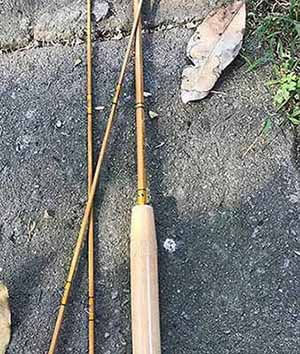
Bamboo has long been the fishing rod since a long time ago. Being fibrous, bendy, flexible, and sensitive to the slightest strike, a bamboo fishing rod will give you an organic feeling in your hand. Best rod to simply experience the classic fun of fishing.
Even though flexible and cheap, it is still heavier than other materials and not so convenient to carry, and will easily bend and brittle, hence they are almost eliminated and replaced by other more acceptable materials, such as carbon fiber and graphite. But due to these disadvantages, plenty of anglers still love bamboo fishing rods for being natural and nostalgic. Their application is now mostly limited to the creek, shallow water, and the pools.
Fiberglass rod blank
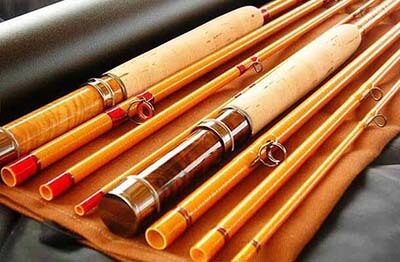
Designed for slow to medium action, glass fiber fishing rods are combined with fiberglass and resin. They are durable, flexible, and less expensive than graphite and carbon fiber. According to individual requirements, the fiberglass rod blanks can be divided into long, extra long, and portable types, the length of which range from one to ten meters.
Fiberglass rod blanks can withstand high tensile force before failure and they are heavier and inappropriate for long-time use. Anglers that love fishing in the small to mid-sized streams will enjoy nice fishing when holding a glass fiber rod.
Carbon fiber rod blank
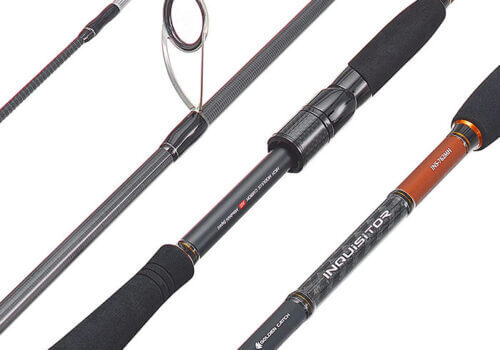
Manufactured to produce great tensile properties, carbon fiber fishing rods are highly sensitive and flexible to detect the slightest vibration caused by a big fish as soon as it bites, and its lightweight property makes it easy to pack for travel. It is the most popular material among all levels of anglers.
Carbon fiber rod blank is lightweight and tensile with high elastic modulus. The amount of carbon fiber in a blank ranges from 30% to 90%, and the higher the carbon amount is, the more expensive the blank will be. It is stiffer than glass fiber and more brittle when misused, while carbon fiber allows for longer and faster blanks.
Carbon fiber also allows for a smaller diameter rod that is more sensitive than a glass fiber rod. Carbon fiber blanks are a good compromise between fiberglass and composite blanks. They can give you all the power that you need to fight and retrieve fish to land the next big catch.
Graphite rod blank

Graphite rod blanks are more sensitive than fiberglass blanks. They are incredibly light which allows you to cast further and more accurately. The tougher property makes it excellent in fighting big fish, so you can have more fish in a better condition.
But it is also easier to bend and brittle. Fractures can be caused by a sudden shock from a big striking fish. The amount of resin and fiber is changeable, and most graphite rods also contain fiberglass to add some extra strength in a certain section of a rod as required. They are appropriate for catching big fish in a large water area.
Although it is widely considered the most appropriate fishing rod material, it also has disadvantages. A sudden shock or a powerful strike from a large fish will cause fractures easily. And the process of producing the graphite fishing rod is complicated, making it much more expensive than other fishing rod materials.
Composite rod blank
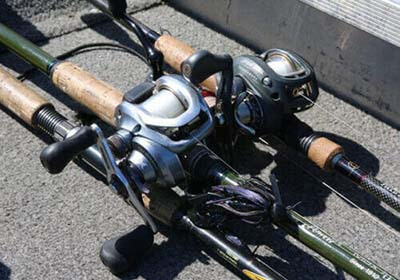
Mixed with graphite and fiberglass, composite fishing rods combine the advantages of both materials. Being more flexible than graphite and less bendy than fiberglass makes it an ideal rod for both beginners and experienced anglers. It is a good middle ground for both beginners and experienced anglers, because they are easier to use than fiberglass and graphite fishing rods. These rods are extremely versatile and can be used in numerous situations. The action of composite rods depends on the ratio of the materials. Most of these are medium-action rods.
Boron nanofiber rod blank
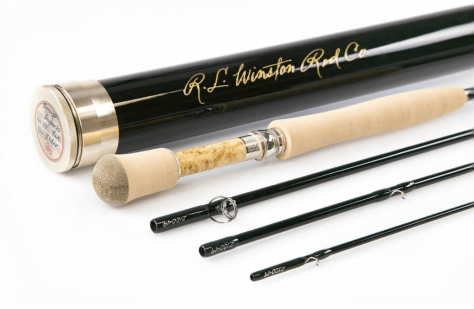
Based on boron fiber, the boron nanofiber is a kind of new and enhanced material processed by nanotechnology. The boron nanofiber fishing blanks generally contain 80% to 90% of carbon fiber. After adding the boron nanofiber, the blank is greatly enhanced. The property of being much tougher, lighter, and flexible than carbon fiber and fiberglass allows it to have greater performance and it will not easily brittle when fighting giant fish. But this advanced material is exclusively occupied by Ukyingda Fishing Tackle International Co.,Ltd.
Titanium alloy rod blank

Titanium rod blanks have set a new standard of high quality and excellence of fishing rod blanks. The titanium fishing blanks have many advantages that too many anglers are looking for. They are extremely light, powerful, and durable, which makes titanium fishing rod blanks exceed other types of materials.
The lightweight property can let the angles fish all day long without feeling tired in the arms or shoulders. Even a beginner will be surprised at how easy and accurate the casting can be when holding the titanium fishing rod blanks. Titanium stores and transfers energy more efficiently than any other rod material on the market.
As for the design, a special physical and chemical process is used to make various patterns to form a unique charm of the titanium fishing rod to accompany your cultural heritage, which combines practicality, beauty, and artistic value.
Composite vs carbon fiber vs graphite vs fiberglass fishing rod blanks
Bamboo fishing rods are used in small polls, creeks, and shallow water. it is heavier than other materials, hence you need to use more power when dragging large fish, and you will feel a little fatigued after long-time use. Now the bamboo fishing rods are also the cheapest in the fishing market. It is good for beginners to purely experience the classic fun of fishing during catching small fish species, such as Bass and trout.
Composite fishing rod blanks combine the benefits of fiberglass and graphite. They can be high-powered to cope with strong wind and striking fish in large water like mid-sized rivers or lakes. Since it is the combination of two materials, it will be heavier than carbon fiber or graphite, and the casting is not as accurate as the graphite rods. Both freshwater and saltwater are applicable.
Titanium fishing rod blanks can be used both in saltwater and freshwater. They can provide such an effortless feeling like no other, and you can fish all day without feeling painful on your shoulders. No matter small or big fish, the titanium fishing rods can do all the work.
Evolved from boron fiber, Boron nanofiber is the newest material for fishing rod blanks, this material is highly temperature-resistant and intensive and its elasticity modulus is as two to three times as that of the steel. However, it is too expensive and rarely used in fishing right now. So as the fishing rod material, it is not the ideal choice of the anglers.
Carbon fiber fishing rod blanks are lighter than fiberglass rods, and they enable accurate and distant casting, and you will not get tired as fast. With the fastest action and high flexibility and sensitivity, a carbon fiber rod blank can cope with almost all the fish in large water.
Graphite fishing rod blanks are similar to carbon fiber fishing rod blanks. The only difference is that graphite breaks apart easily and carbon fiber is stronger. The graphite fishing rod blanks can cope with large and violent fish both in saltwater and freshwater, as it is tougher than fiberglass and the casting is more accurate and further. Long-time use will not make you feel fatigued.
Fiberglass fishing rod blanks are usually slow- or medium-action rods. it is widely used carbon fiber comes out. They are sort of heavier than carbon fiber and not available in extended sizes are not available, and you may feel a little fatigue if you use them in the large stream for a long time. Ideal for small creeks and streams.
For your convenience and reference, below is the summary table of pros and cons of these six materials
| Pros | Cons | |
| Fiberglass |
Least expensive Flexible for optimum drag Durable Low maintenance Lightweight |
Little sensitivity Low power Reduced accuracy at longer distance |
| Composite |
Customizable speed/action Durable Versatile Flexible |
Often more expensive than fiberglass Less accuracy than graphite |
| Carbon fiber |
Super sensitive Lightweight Powerful Flexible |
Brittle/rigid Most expensive Fragile |
| Graphite |
Super sensitive Lightweight Powerful Precise |
Brittle/rigid Most expensive |
| Titanium |
Extremely light Sensitive Powerful Durable |
Highly reactive Heat conductive |
| Bamboo |
Artistic Cheap Flexible |
Brittle easily Heavy inconvenience |
3. What is the Best Material for a Fishing Rod?
There is no size fits all when it comes to fishing rod materials. None of them are versatile. Each material has its pros and cons. Whether a fishing rod material is the best depends on many factors which are including but are not limited to rod style, components, rod length, power and action, environment, and your experience.
However, graphite is considered by many experienced anglers the best material to make a fishing rod blank, for it can withstand more powerful conditions and has a better performance in catching larger fishes. Graphite fishing rods, due to their high sensitivity, can allow the angler to easily detect the strikes caused by a big fish and its rigidity also makes it more powerful in hook sets.
But beginners can benefit from fiberglass rods due to their durability and easy maintenance. No matter larger or smaller fish species, a fiberglass rod can give the beginners a better performance.
4. Materials of Fishing Rod Handle
The grips on fishing rods are made of plenty of materials, among them, foam, cork, and are widely used.
Cork rod handle
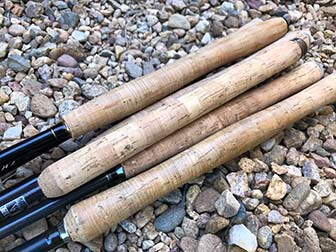
As the rod handle, cork has been the preferred material for well over a hundred years, and now it is still the primal choice to many anglers, since it is more comfortable and less slippery than foam-wrapped handles. You will not feel that cold when using the cork handle under freezing weather conditions. The property of cork makes the handle more sensitive to fish bites and it is also light enough for jigging or casting all day.
Cork will get dark as it touches the dirt, sweat, and fish slime, it is soft and will have gashes if abused. Because the cork handle is manufactured from the cork tree which is prone to diseases, so sometimes the shortage of the cork will drive up the price.
Foam rod handle
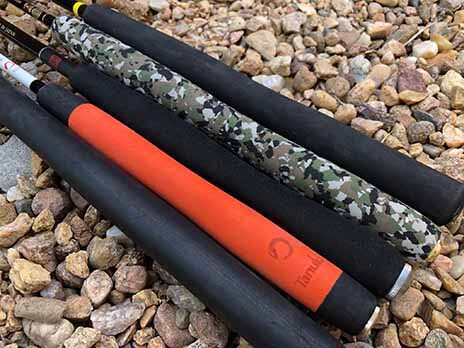
The foam handle will stay warm in winter, and if the quality is good, it will be as light as the cork. Compared with the price of cork which is in shortage sometimes, the foam is less expensive. The surface of the foam will not be as dirty as that of the cork after long-time use. It will seldom collect any dirt or sweat, or even the fish slime.
But the foam handle will degrade over time and since it is elastic, it will have a shorter lifespan than people may think, it may eventually become crispy and lose its elasticity. Due to the property of the foam sometimes it will not degrade rapidly, as a result, it will cause pollution and waste. And your hand will not feel as great as it does to the cork when you hold the foam handle.
For better understanding, here is a table to know the pros and cons of these two common rod handle materials.
| Material | Pros | Cons |
| Cork |
Natural and recyclable Lightweight Warm High sensitivity Good grip Hydrophobic |
Hygiene issue Less durable Less smooth Expensive sometimes |
| Foam |
Inexpensive Long-lasting Soft and smooth Easy to clean Hydrophobic |
Not eco-friendly Low energy transfer Less heat retention The grip is not great Dampen strike detection |
The rod grips can be divided into two kinds by function which is split handle and full handle. The difference between them is that the full handle is just in one piece wrapping the rod butt, and the split handle has the part of the grip that is missing. As two different handles, although they have shortcomings, they still have loads of value to offer. You can look through the table below to know their pros and cons.
| pros | cons | |
| Full rod handle |
Better for two-hand use Suitable for heavier rod |
Heavier Less accurate and sensitive |
| Split rod handle |
Lighter Better for one-arm use Higher accuracy Better control |
Inappropriate for large fish |
5. Materials of fishing rod tip
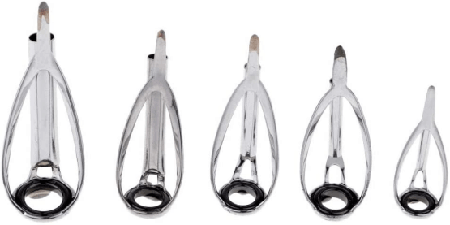
The fishing rod tip, also known as tip top, is made of stainless steel and a SIC ring. It is the
metal guide at the very tip of a fishing rod, and also the last component the line leaves before making its entrance into the water. A tip top includes two key dimensions which are the tube size and ring size.
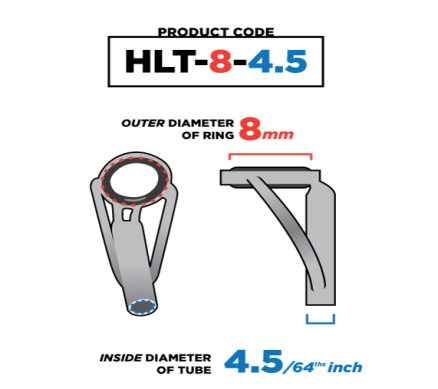
HLT (Halide Light Top) means the style of the top, while “8 mm” means the outer diameter of the ring. “4.5” means the inside diameter of the tube.
6. Materials of fishing reel seat
There are generally 6 types of reel seats in the fishing market. They are spinning seat, casting seat, fly seat, saltwater seat, aluminum butt, and ice seat. But casting and spinning seats are widely used by all levels of anglers.Usually a reel seat includes:
- Body – main structure often made of aluminum and graphite
- hood– installed over reel foot for better stability and security
- Locking Nut – tightens or loosens hood’s position over the reel foot
- Barrel Threads – channel for locking nut to screw up or down
- Trigger – ergonomic structure underneath casting seats for increased control
But casting and spinning seats are preferred by all levels of anglers, and they are for different types of reels. Casting seats are designed for baitcast and spincast reels, while spinning seats are designed for spinning reels. These three reels are the main ones used today.
Below is the table of advantages and disadvantages of these three reels.
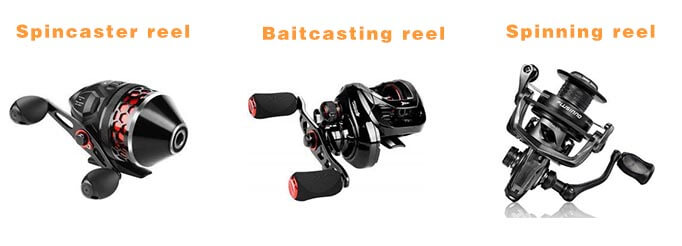
| Reel | Advantages | Disadvantages |
| Baitcaster |
Durable and lightweight Suitable for heavier line Can handle powerful fish Strong drag capability Highly customizable |
More expensive Hire learning curve Backlash Difficult to switch directions |
| Spincaster |
Cheap Easy to use Suitable fore lightweight line No backlash Suitable for in shore fishing |
Not much strong Line can tangle Less drag ability No distance control |
| Spinning |
Higher quality Cheaper than baitcaster reel Suited for multiple habitats Better control over drag and distance Suitable for lighter lures and lines |
Unsuitable for heavy lure Improper for large fish |
7. Materials of hook keeper

Hook keeper is often equipped slightly in front of your rod handle to give you a handy space to hold your lures, and it is a good way to store the lure after you finish your fishing thing at the end of your day. Hook keepers are made of plated stainless steel. With this advanced material, heat and friction are maximally reduced.
8. Materials of rod guides
Rod guides are the circular pieces through which your fishing line is threaded for better fishing control. Generally, they are made out of plastic, metal, or ceramic materials, but today silicon carbide and titanium carbide are considered to be the best material for fishing rod guides due to their ability of lightweight and durability.
There are several different rod guides. They are:

- Micro guides – can be used on both spinning and baitcasting reels and add minimal weight, and leave the smallest footprint on the rod
Single foot – have less impact on the action of the rod
Double foot – can stay securely anchored and resist twisting even under heavy loads, suitable for fishing large species
Roller guide – minimize the friction between the line and guides when large fish strike against tight drag settings
9. Are expensive rods really the best?
Theoretically, the more expensive a fishing rod is, the better its quality will be. When you use a fishing rod you can feel the difference between the cheap one and the expensive one. The expensive rods are better in sensitivity, detection of smaller fishes and it will bring you more fun when you use them for fishing.
However, due to the difference in materials and manufacturing process, the price of the rods will vary quite much, even the fishing rods with the same material, if processed by different manufacturers with different techniques, will also have various prices. There are definite chances that a beginner is tricked to buy a shoddy rod at a good price. The fishing market is a mixture of good and bad fishing rods, and beginners can hardly distinguish them.
Moreover, a certain material only works well under certain situations, and they are designed for various fish species and different levels of anglers, so from these perspectives, it does not always mean that an expensive rod is the best choice for you under all the conditions. You have to ask yourself if your fishing frequency is enough to make the rod worth it. The best fishing rod shall be the one that suits you most rather than the expensive one.
10. How to choose a fishing rod for beginners? (very practical tips)
To be honest, due to the needs and profession of an angler, it is hard to say which material is better, because all the materials have their advantages and disadvantages in different scenarios, but if a beginner wants to choose an ideal fishing rod, there are several critical features that he needs to pay attention to, and they are material, length, power, and action. Now let’s take a further step to analyze these critical factors and their parameters and how will they affect your fishing performance.
Material
There are two good choices for beginners, fiberglass and carbon fiber.
Fiberglass is relatively inexpensive. Its flexibility and tensile force, even though not as good as carbon fiber, are still enough for new anglers who are on a budget.
Compared with fiberglass, carbon fiber is more expensive and lighter than fiberglass, so that makes the fishing rods easy to carry and operate even for beginners. Another thing is that carbon fiber has good corrosion resistance, and the rods will not be easily damaged when they are used.
But when choosing the carbon fiber fishing rod, beginners need to consider the carbon tonnage. Generally, the higher the carbon tonnage is, the stiffer and lighter a fishing rod will be, and more vibration can be transmitted through the rod. A rod is constituted by different tonnages of carbon, and the tonnage of carbon usually includes 24T, 30T, 36T, 40T, 46T, and 55T. But it does not mean that the fishing rod with a low tonnage of carbon is not a good one. There are plenty of fishing rods with a low tonnage of carbon that still works well on fighting large fish.
Length
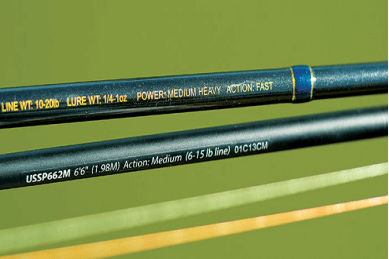
No matter you are a beginner or an experienced angler, fishing rod length is one of the factors that you can never overlook. The length parameter is always printed on the surface of your rod, and most modern fishing rods typically range from 6 to 12 feet. Length will affect your fishing performance in your casting and accuracy, generally compared to the shorter rods, the longer rods can cast further, but less accurate than the shorter ones when exerted with the same power. So when you choose the right length, make sure fish species and fishing environment are considered. The recommended rod length for beginners is around 7 feet. This size can allow beginners to cast smoothly without losing accuracy.
Power
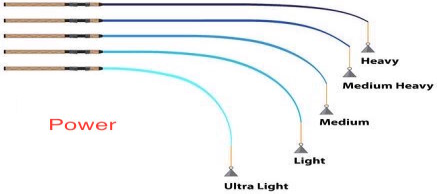
Printed on the surface of the rod, power refers to the pressure and resistance a rod requires to be bending under a certain amount of weight. Rod power are typically defined as “Ultra Light”, “Light”, “Medium Light”, “Medium”, “Medium Heavy”, “Heavy”, “Extra Heavy”.
Ultra-light rods are more suited for small fish, while ultra-heavy rods are used in deep-sea fishing excursions. Power is positively related to the lure, line, and weight of a fishing rod, and choosing an appropriate blank to match the right lure and line would be a key to maintain reliable and fruitful performance. For your reference, here is a table to show the correct match among lure, line, and rod.
| Rod Power | Line Weight | Line Size |
|
Ultra-Light |
1-4 lb test |
1/64 - 1/16 oz |
|
Light |
4-8 lb test |
1/16 - 1/4 oz |
|
Medium Light |
6-10 lb test |
1/4–1/2 oz |
|
Medium |
8-12 lb test |
1/2–1 oz |
|
Medium-Heavy |
12-25 lb test |
1–4 oz |
|
Heavy |
20-40 lb test |
4–8 oz |
|
Extra Heavy |
25 lb test and above |
8 oz or above |
Action
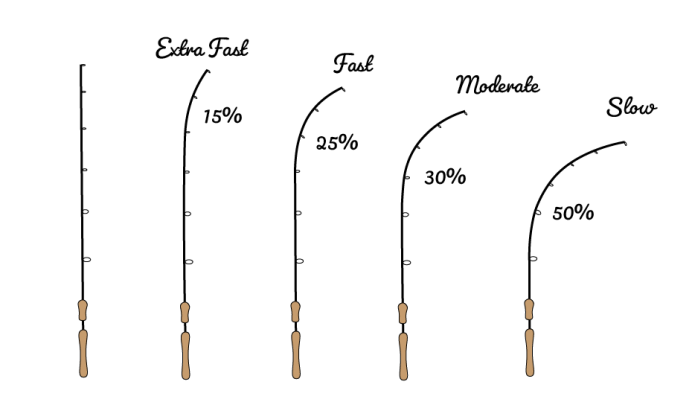
Just like the power and length, “action” is also printed above the fishing rod. It describes where the bending takes place when the weight is applied. The action is generally rated as “slow”, “moderate”, “mod-fast”, “fast”, and “x-fast”. The bending will gradually be closer to your rod butt when the action becomes relatively slow. The fast action rods flex near the rod tip, providing excellent sensitivity, hence it is the most common action rating.
The moderate action rods will bend 30 – 40 percent near the tip, allowing anglers to fish both small and large species. Compared with fast action rod, it will offer less long casting distance and enough hook setting power. This kind of rod can be used in a variety of conditions, and can effectively absorb the shock produced by some violent fish.
The slow-action rods will bend throughout the entire length of the rod, producing the most flexible action. They are quite proper for fishing small species. And the casting will be slower but good for beginners to use. Below is the table to show you the features of these three different action rods.
Besides the factors mentioned above, you still need to consider other factors, such as your preference, budget, technique, you can also look through the following questions to figure out your best fishing rod.
- Are you going to angle on boat or land?
- What water area are you going to angle?
- Do you want to carry a rod with you when you travel?
- Do you angle all day or just for a short of time?
11. Future trend of fishing rod
We have witnessed a great advancement in fishing things over the recent years, probably in the near future, the fishing rods will be different. manufacturers of the fishing poles are continuing to develop new products to make all the anglers have a better fishing experience. Moreover, the fishing rods will be more specialized, which means that the fishing rods will be particularly designed to catch fish of different sizes and types.
Today the fishing rods are designed with a specific purpose to accurately cope with a variety of fish and conditions. They will be much human-friendly as well as smart. You may even use a smart rod sensor that is controlled through your smartphone to help you perform much better when you are fishing.
As technology advances, more and more new equipment will be produced to help the anglers cast their lines further and more accurately. Fishing by then will have been more enjoyable.
In Conclusion
If you think this article is helpful for you, you can share it with your friends or on Facebook, Reddit, and Quora. If you have other questions, leave messages below and we’re glad to help you.
We‘re Jingsourcing, a leading sourcing agent in China. If you want to wholesale or customize fishing rod blanks or other components, please feel free to CONTACT US.

Leave A Comment